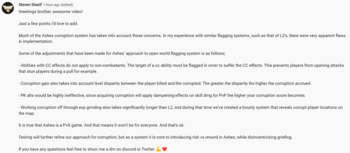Pilares de design
Saltar para a navegação
Saltar para a pesquisa
O design de Ashes of Creation adere a cinco Pilares de Design.[1]
Ao projetar o Ashes of Creation, nós aderimos cada detalhe a cinco pilares principais: História Imersiva, um Mundo Reativo, Interação entre Jogadores, Agência do Jogador, e Risco vs Recompensa. Mesmo no ambiente, tudo o que você, como jogador, faz, vai amarrar a estes pilares, enquanto tudo o que sua guilda faz, tudo o que seu servidor faz, no final das contas, vai manter o mundo fresco, sempre em mudança e, o mais importante... excitante.[1]
Histórico
Originalmente existiam "quatro" pilares de design: Economia, Nodes, Risco vs Recompensa and Narrativa.[2]
Inspiration
Ashes of Creation has taken inspiration from various other MMORPG titles.[3]
- In terms of what came before, we're trying to figure out who did what best and take inspiration from that: Move the genre forward; keep things updated and bring it into the 21st century.[3] – Jeffrey Bard
- Eve Online with its regionalized economy and risk vs reward in transportation.[3]
- ArcheAge with its building systems, transportation and naval combat.[3]
- Star Wars Galaxies with its crafting systems.[3]
- Lineage II with its risk vs reward, castle sieges, flagging, open world PvP and guild progression.[4][5][6][3]
- A lot of the systems in Lineage 2 were based around a concept that got lost today in mmorpgs, and that's risk versus reward. You know this idea that the more you risk the greater potential reward should be present is a complete paradigm shift away from everyone's a winner, everybody gets a participation reward, and here you go, congratulations you're a player in this game; and that's boring. It gives nothing for a person to aspire to achieve something, or to feel the bite of loss when you fail. Those are the driving forces of why people want to play games and it's a reason why new games when they come out have such a short lifespan, because they are always competing with WOW. You don't have to compete with WOW. You don't have to be a WOW killer. You can focus on something that is different from a philosophical design standpoint; and I think that's just what a lot of studios today don't want to take the risk on.[5] – Steven Sharif

